Related Research Articles

Mentmore Towers, historically known simply as "Mentmore", is a 19th-century English country house built between 1852 and 1854 for the Rothschild family in the village of Mentmore in Buckinghamshire. Sir Joseph Paxton and his son-in-law, George Henry Stokes, designed the building in the 19th-century revival of late 16th and early 17th-century Elizabethan and Jacobean styles called Jacobethan. The house was designed for the banker and collector of fine art Baron Mayer de Rothschild as a country home, and as a display case for his collection of fine art. The mansion has been described as one of the greatest houses of the Victorian era. Mentmore was inherited by Hannah Primrose, Countess of Rosebery, née Rothschild, and owned by her descendants, the Earls of Rosebery.
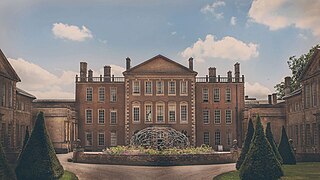
Aynhoe Park is a 17th-century country estate consisting of land and buildings that were rebuilt after the English Civil War on the southern edge of the stone-built village of Aynho, Northamptonshire, England. It overlooks the Cherwell valley that divides Northamptonshire from Oxfordshire. The core buildings represent four architectural periods: Jacobean, Carolean and both the early 18th and 19th centuries.

Aynho is a village and civil parish in West Northamptonshire, England, on the edge of the Cherwell valley 6 miles (9.7 km) south-east of the north Oxfordshire town of Banbury and 7 miles (11 km) southwest of Brackley.
Bramshill is a civil parish in the English county of Hampshire. Its name has become synonymous with the Police Staff College, Bramshill located in Bramshill House. Bramshill forms part of the district of Hart. It is bordered by the Rivers Whitewater, Blackwater and Hart and by the villages of Farley Hill, Eversley, Hazeley, Heckfield, Riseley and Swallowfield.

Gosford Castle is a 19th-century country house situated in Gosford, a townland of Markethill, County Armagh, Northern Ireland. It was built for Archibald Acheson, 2nd Earl of Gosford, and designed in the Norman revival style by London architect Thomas Hopper. It is a Grade A listed building, and is said to be Ulster's largest. The Earls of Gosford occupied the castle until 1921, and the estate was later purchased by the Ministry of Agriculture to form Gosford Forest Park. The building subsequently deteriorated and in 2006 was sold to a development company who converted the castle into private dwellings.

Burwood Park is a historic private estate located in Hersham, Surrey, England. Spanning six miles of road, Burwood Park is situated in a former deer park that belonged to Henry VIII. The 360 acre estate is known both for its extensive wildlife — more than 150 species of birds and mammals have been recorded in the woods and parkland around its lakes and communal areas —.as well as the high level of security and privacy provided to its residents; it is one of the few remaining residential areas in the United Kingdom never to have been filmed by Google Streetview.
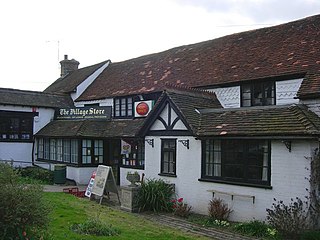
Dormansland is a large village and civil parish with a low population approximately one mile south of Lingfield in Surrey, England. It was founded in the 19th century and is bordered on the east by the county of Kent and on the south by West Sussex and East Sussex, the only area of the county which borders East Sussex. The nearest town is the small town of East Grinstead, immediately across the West Sussex border.

Danny House is a Grade I listed Elizabethan red brick mansion near Hurstpierpoint in West Sussex, England. It lies at the northern foot of Wolstonbury Hill and may be regarded as one of the finest stately houses in Sussex, with 56 bedrooms and 28 apartments. The present house was built 1593–95 by George Goring, on the site of an older house. It is set in eight acres of gardens at the foot of the South Downs within an historic parkland of some 400 acres, which was granted by royal charter in 1333.

Apethorpe Palace, formerly known as "Apethorpe Hall", is a Grade I listed country house, dating to the 15th century, close to Apethorpe, Northamptonshire. It was a "favourite royal residence" for James I.
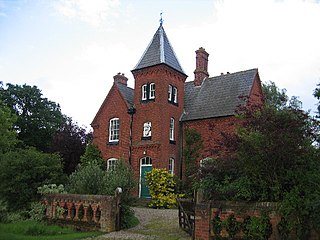
Haseley is a small village and former civil parish in Warwickshire, England. It is four miles north-west of the county town of Warwick and nine miles (14.5 km) south-east of Solihull, now in the parish of Beausale, Haseley, Honiley and Wroxall, created on 1 April 2007. The village is on the A4177 and, as it is only five miles (8 km) from the M40 motorway, is easily accessible. Haseley proper, along with Haseley Knob, Haseley Green and Waste Green, consists mainly of detached houses spread over a large area, giving the parish a very low housing density. The 2001 census recorded 207 residents living in 92 dwellings. It is an affluent area, with an average house price of around £277,000. Due to this and its proximity to the tourist towns of Warwick and Stratford upon Avon, several large and highly rated hotels are around the village.

Albury Park is a country park and Grade II* listed historic country house in Surrey, England. It covers over 150 acres (0.61 km2); within this area is the old village of Albury, which consists of three or four houses and a church. The River Tillingbourne runs through the grounds. The gardens of Albury Park are Grade I listed on the Register of Historic Parks and Gardens.

Great Maytham Hall, near Rolvenden, Kent, England, is a Grade II* listed country house. The gardens are famous for providing the inspiration for The Secret Garden by Frances Hodgson Burnett.

Swallowfield Park is a Grade II* listed stately home and estate in the English county of Berkshire. The house is near the village of Swallowfield, some 4 miles south of the town of Reading.
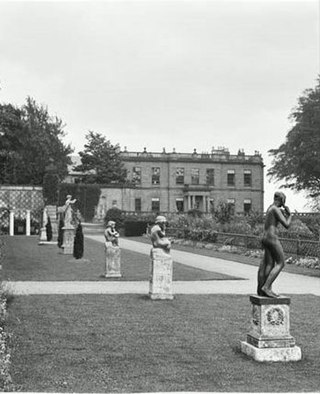
Windlestone Hall is a mid-16th century Elizabethan country house, heavily rebuilt in 1821 to form a Greek revival stately home, situated near Rushyford, County Durham, England. The Hall sits within 400 acres of designed parkland. It is a Grade II* Listed building. As of 2022 it is back in private family ownership, with the surrounding estate maintained and conserved by a dedicated heritage charitable trust.
Country house conversion to apartments is the process whereby a large country house, which was originally built to accommodate one wealthy family, is subdivided into separate apartments to allow multiple residential occupancy by a number of unrelated families. They are usually, by virtue of their age or style, listed buildings. The re-purposing of these mansions is one alternative to their demolition; there was wide-spread destruction of country houses in 20th-century Britain, but remodelling them as multiple dwelling units became a more popular option after the Destruction of the Country House exhibition in 1974.

Gordon Hall, also known as the Judge Samuel W. Dexter House, is a private house located at 8341 Island Lake Road in Dexter, Michigan. It was designated a Michigan State Historic Site in 1958 and listed on the National Register of Historic Places in 1972. The house is unique in Michigan for its balance, large scale, and massive hexastyle portico. The structure is also significant as the dwelling of Judge Samuel W. Dexter, a pioneering Michigan resident and land baron who had a substantial impact on early development of Washtenaw County and other sections of the state. The house was later owned by Dexter's granddaughter Katharine Dexter McCormick, a pioneering research scientist, suffragist, and philanthropist. In its early days, Gordon Hall hosted at least two, and possibly three United States presidents, and it was almost certainly a stop along the Underground Railroad.

Gray Rock is a historic plantation home located in Ellicott City, Maryland.
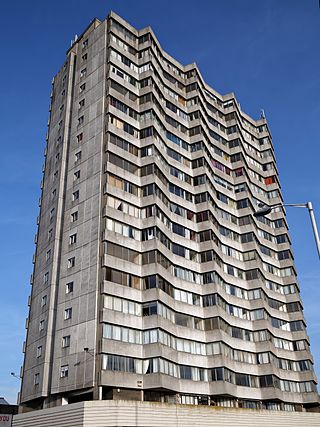
Arlington House is a 20-storey residential apartment with 18 floors of flats on the seafront of Margate, Kent, England, next to Margate railway station and Dreamland Margate. It was developed by Bernard Sunley and designed by Russel Diplock, and is known for every apartment having a sea view. The building was designed in the style of Brutalist architecture.

Greathed Manor, Dormansland, Surrey, is a Victorian country house. Designed by the architect Robert Kerr in 1862–8, it is a Grade II listed building.

The New Jewish Home is an American nonprofit older adult health care system based in New York City. The organization serves older adults of all religions and ethnicities at its three campuses in Manhattan, The Bronx, and Mamaroneck in Westchester County. It provides rehabilitative services, skilled nursing, senior housing, and numerous home health programs, including a certified home health agency and a home care agency. The organization was founded in 1848 by Hannah Leo of the B'nai Jeshurun Ladies' Benevolent Society.
References
- ↑ "Residents are saved from eviction". BBC News: Devon. 19 April 2004. Retrieved 21 November 2022.
- ↑ BBC News article "Historic houses to close" on 15 December 2003
- ↑ The Telegraph, "Eight historic houses for sale in charity cash crisis", by John Eifion Jones and Pippa Dunlop, 15 December 2003
- ↑ The Telegraph, "Stately homes fetch £20m", by Mark Palmer 26 March 2004
- ↑ "Country Houses Foundation "What is CHF" web page". Archived from the original on 6 October 2008. Retrieved 9 October 2008.